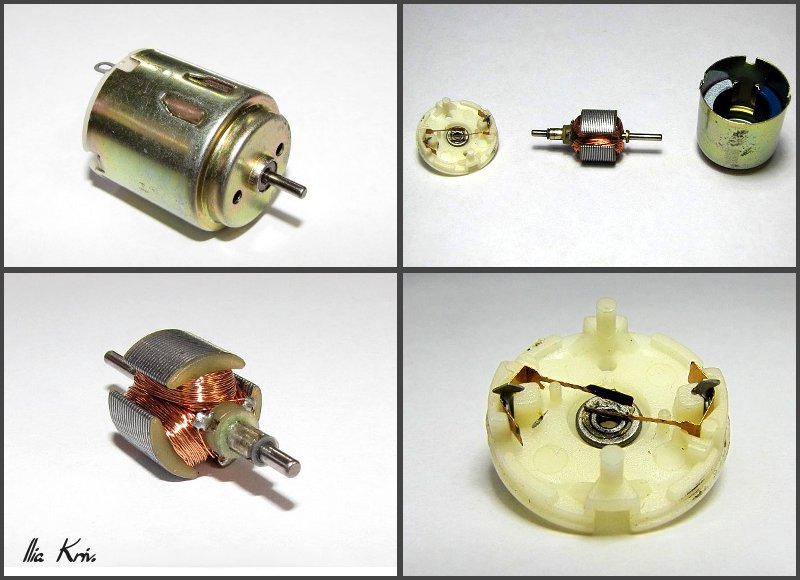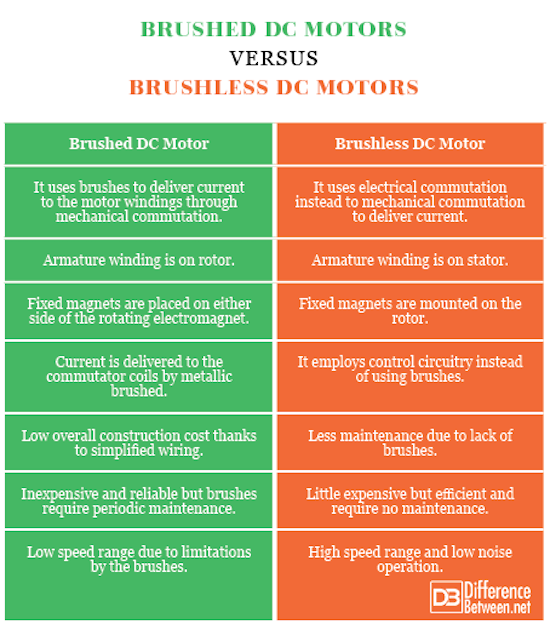Difference Between Brushed Motors and Brushless Motors
Brushed DC motors have been around since the late 1800s, mainly used for cranes, electrical propulsion, and steel rolling mills. But they have been supplanted by their brushless counterparts lately. Any expert should understand the difference between brushed and brushless motors.
As the name suggests, it’s brushes of course, but there’s more to it than it seems. Well, they both are essentially the same when it comes to how they work. Although the principle behind how they work on the inside is quite same, they mainly differ in the way the electric current is routed to the electromagnets, maintaining electromotive repulsion/attraction, eventually causing the rotor to continue turning.
Though it’s the brushes that do all the working or so, many people won’t get what exactly the brushes mean. Let’s take a look at the two and understand the difference between the same.

What is a Brushed DC Motor?
Brushed DC motors are one of the simplest types of DC motors used since the late 1800s. The typically consists of a pair of permanent magnets as the “stator” and a motor coil as the “rotor” connected to a commutator.
Permanent magnets are always mounted on the stator and the current-carrying conductors are always located on the turning part. They are practically powered by a direct current power source and the current is transferred to the coils by metallic brushes which rotate along with the rotor. Though they are quite efficient but they require periodic maintenance of brushes.

What is a Brushless DC Motor?
Brushless DC motors do not make use of commutation to regulate the current flow inside the coils; instead, they are powered by a DC electric source via an integrated switching power supply, which produces an AC electric signal causing the motor to drive.
Unlike brushed motors, the permanent magnets are always attached to the rotor and the current-carrying conductors are located on the stator. What’s done with brushes in brushed motors mechanically are practically done through the electronics of the brushless DC controller.
Difference between Brushed and Brushless Motors
Basics of Brushed Vs. Brushless Motors
Both brushed and brushless DC motors are essentially the same, when it comes to working principle.
The difference is mainly in the efficiency and by efficiency means the total power being used by the motor which is turned into rotational force is lost to heat.
A brushed DC motor is one of the simplest types of motor that run on a direct current power source where the brushes inside the motor deliver current to the windings through creation of magnetic fields which keeps the rotor turning.
Brushless motors, also known as synchronous motors, lack brushes and they move around electronically. Instead of using brushes, the motor employs control circuitry.
Construction of Brushed and Brushless Motors
The main difference lies in the name. Brushless DC motors don’t use any of the current carrying commutators to deliver current, whereas a brushed DC motor uses brushes to charge the commutator which in fact, delivers current to the motor.
A typical brushed DC motor consists of a rotor (armature), brushes, a commutator, a filed magnet, and an axle. A brushless DC motor has a stator and a rotor where the permanent magnets are mounted. The stator is wound with a sequence of coils.
In brushed motors, windings are on the rotor, whereas they are on the stator in brushless motors.
Working of Brushed Vs. Brushless Motors
Brushed motors use mechanical commutation of the windings via brushes instead of using a controller to switch current in the windings. The brushes charge the commutator inversely in polarity to the fixed magnet, causing the armature to rotate. When these windings are energized they produce a magnetic field whose attraction and repulsion keeps the rotor turning. As the rotor turns, the windings are constantly being energized in a different sequence so as to keep the rotor rotating within the stator filed.
Brushless DC motors, on the contrary, use a permanent magnet as their external rotor. Unlike brushed motors, they use electrical commutation to convert electrical energy into mechanical energy.
Applications of Brushed Vs. Brushless Motors
Both can be found in a wide range of applications. Brushed DC motors, though, are mainly found in household appliances and in automobiles. Brushed motors are still used for industrial purposes for both low and high power, fixed and variable speed electric drives.
They are still used for paper machines, cranes, electrical propulsion, sewing machines, power tools, and steel rolling mills. Brushless motors, thanks to their reliability and longevity, have expanded into many applications. They are primarily used in actuation, servo, and positioning and variable speed applications, mainly for industrial or manufacturing processes.
Additionally, they are used in some power tools and next generation electric vehicles, and even underwater mapping for marine applications.
Brushed vs. Brushless DC Motors: Comparison Chart

Summary of Brushed Vs. Brushless Motors
Although, both brushed and brushless DC motors are essentially the same, in terms of working, the difference is quite subtle.
As the name suggests, brushed motors use metallic brushes to deliver current to the motor windings, whereas brushless motors lack brushes; instead, they employ control circuitry instead of using brushes. But that doesn’t make them any less efficient than their brushed counterparts.
In fact, brushless motors are more efficient in converting electrical energy into mechanical energy and they don’t require regular maintenance due to the lack of brushes, plus they operate effectively at all speeds with less noise.
Additionally, the components are more efficient as there’s no significant power loss across brushes which accounts for better heat dissipation.
- Difference Between Caucus and Primary - June 18, 2024
- Difference Between PPO and POS - May 30, 2024
- Difference Between RFID and NFC - May 28, 2024
Search DifferenceBetween.net :
1 Comment
Leave a Response
References :
[0]Scarpino, Matthew. Motors for Makers: A Guide to Steppers, Servos, and Other Electrical Machines. Seattle: Que Publishing, 2015. Print
[1]Irwin, J. David. The Industrial Electronics Handbook. Florida: CRC Press, 1997. Print
[2]Tong, Wei. Mechanical Design of Electric Motors. Florida: CRC Press, 2014. Print
[3]Image credit: https://commons.wikimedia.org/wiki/File:Brushed_dc_motor_assembly.jpg#/media/File:Brushed_dc_motor_assembly.jpg
[4]Image credit: https://www.flickr.com/photos/kasparsdambis/28137980911

Sagar – I am a retired biologist and amateur woodworker. A fellow woodworker with a shop in his basement recently bought a HEPA filtration system and used a light scattering particle counter. With the HEPA filtration system off he recorded approximately 100 particles between 0.5 and 2.5 micron. When he turns the HEPA system on, counts go over 400. Nothing else has changed other than turning on the HEPA system. Someone suggested that this was carbon coming off of the brushes. He has evaluated a number of new HEPA filtration systems and observed similar high numbers. One filtration system he checked which had been in operation for a while had lower numbers. This leads me to believe there is some validity to this. Does this sound plausible? How long would you expect counts to be this high before they start to decrease? Since these are to decrease wood dust, one would think the manufacturers would be concerned about any dust and would have gone to brushless motors.